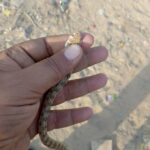Venomous Snakes Around Us: The Big Four of India 
India is home to over 350 snake species, but four venomous species—Cobra, Krait, Saw-Scaled Viper, and Russell’s Viper—are responsible for the majority of snakebite cases. Understanding these snakes can help in prevention and coexistence.
1. Cobra (Naja naja) 
- Identification: Hood with distinctive spectacle-like markings (in some species).
- Habitat: Found in forests, grasslands, agricultural fields, and urban areas.
- Venom Type: Neurotoxic, affecting the nervous system, causing paralysis and respiratory failure.
- Behavior: Generally avoids humans but can become aggressive if threatened.
2. Krait (Bungarus spp.) 
- Identification: Glossy black or bluish body with white bands, slender body.
- Habitat: Common in fields, near water bodies, and sometimes inside homes.
- Venom Type: Neurotoxic, causing muscle paralysis and respiratory distress.
- Behavior: Nocturnal and secretive, bites often occur when people unknowingly step on them.
3. Saw-Scaled Viper (Echis carinatus) 
- Identification: Small but highly aggressive, rough scales, distinct zigzag patterns.
- Habitat: Dry, rocky areas, deserts, and scrublands.
- Venom Type: Hemotoxic, causing severe bleeding, clotting disorders, and tissue damage.
- Behavior: Moves in a sidewinding motion and produces a distinct hissing sound by rubbing its scales together.
4. Russell’s Viper (Daboia russelii) 
-
- Identification: Large, thick-bodied snake with chain-like patterns along its back.
- Habitat: Found in grasslands, farmlands, and urban outskirts.
- Venom Type: Hemotoxic, leading to internal bleeding, kidney failure, and multi-organ damage.
- Behavior: One of the most aggressive vipers; delivers high venom yield in a single bite.
Information about Snakes
Understanding Their Presence & Importance
Snakes are an essential part of our ecosystem, found in forests, grasslands, wetlands, agricultural fields, and even urban areas. Their presence helps control rodent populations, preventing crop damage and the spread of diseases. Despite common fears, most snakes are harmless and non-aggressive, attacking only when threatened.
With rapid urbanization and habitat destruction, snakes are increasingly entering human settlements, leading to frequent human-snake encounters. This often results in fear-driven killings, despite the fact that snakes play a vital role in maintaining ecological balance.
By understanding snake behavior, respecting their habitat, and spreading awareness, we can minimize human-snake conflicts and promote coexistence. Awareness and education are key to ensuring a safer environment for both humans and snakes.
Why Awareness Matters?
These four snakes contribute significantly to snakebite fatalities in India due to their proximity to human settlements. Quick identification, proper first aid, and timely medical intervention with Anti-Snake Venom (ASV) can save lives. Instead of fear, knowledge and conservation efforts can help promote safe human-snake coexistence.
[give_form_grid columns="3" show_goal="true" show_excerpt="true" show_featured_image="true" forms_per_page="6"]




